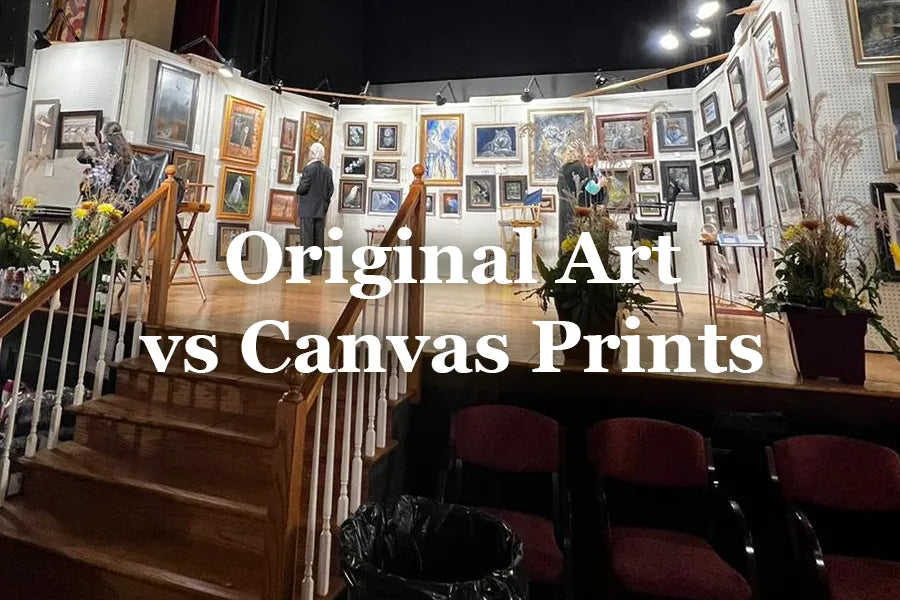How to Appreciate the Intricacies of Landscape Painting
If you've ever stood in front of a landscape painting and wondered what makes it appealing, you're not alone. Landscape art is simply not just a pretty; it's a study of nature, connected through human emotion. Let's look at the elements which can deepen your appreciation and understanding of landscape art.
 "Stillness" oil painting by Chuck Black
"Stillness" oil painting by Chuck Black
Understanding Composition
The layout of a landscape painting can make or break the impact it has on viewers. Look for how the artist uses elements like the rule of thirds or the golden ratio to direct your gaze. These are classic techniques that can subtly guide the viewer's eye to the painting's focal point. For example, leading lines, such as a river or path can serve as guides, moving your eyes through the painting and inviting you into the scene. Likewise, the use of framing elements, like trees or mountains, can create a natural border, directing focus toward the main subject.
The way elements are balanced in the painting also speaks volumes. Perfect symmetry might bring a sense of peace and stability, while an asymmetrical balance could add a level of tension or intrigue. Don't overlook the 'negative spaces' either. These areas contribute to the overall composition, providing breathing room that compliments the focal points.
 "The Oxbow" oil painting by Thomas Cole, 1836
"The Oxbow" oil painting by Thomas Cole, 1836
Color and Emotional Resonance
Colors aren't merely aesthetic choices; they also can carry significant emotion. From warm hues like reds and oranges that evoke feelings of passion to cooler tones like blues and greens that induce a sense of calm, each color serves a purpose. Artists intentionally choose color palettes to resonate with certain viewers and create specific atmospheres.
Complementary colors, which are opposites on the color wheel, can create vibrant, eye-catching scenes. On the flip side, analogous colors, which are close together on the color wheel, often produce a more harmonious effect.
Another fascinating aspect to consider is the intensity of color. Saturated colors can add drama and attract attention, while more subdued or muted palettes might convey introspection or even sadness. It's not just about a single hue, but how a mix of colors works together to tell a greater story.
 "Starry Night Over the Rhône" oil painting by Vincent van Gogh, 1888
"Starry Night Over the Rhône" oil painting by Vincent van Gogh, 1888
Texture and Technique
Texture and technique in landscape painting are like the voice in a song, shaping how the message is delivered and felt. They can add layers of complexity, creating dimension that invites us to take a closer look. From the grainy feel of sand to the smooth surface of a lake, different techniques capture different aspects of nature.
One captivating method is impasto, where paint is laid on an area of the surface very thickly. When done by a skillful hand, impasto can make you want to reach out and touch the canvas. It adds a three-dimensional quality, making the scene jump out and interact with the viewer.
Dry brushing is another technique that creates a different kind of texture. Here, a paintbrush with very little paint is dragged across the canvas. The resulting texture is rough, capturing the essence of coarse surfaces like tree bark or rocky terrain.
Then there's glazing, a technique that involves applying thin layers of transparent paint on top of dry layers. This adds depth and luminosity, subtly changing the appearance of underlying colors. It's often used to create atmospheric effects like mist or to portray shifting light conditions.
 "A Sunday Afternoon on the Island of La Grande Jatte" by Georges Seurat, 1886
"A Sunday Afternoon on the Island of La Grande Jatte" by Georges Seurat, 1886
The Importance of Light
Light is a storytelling tool that artists heavily rely on in landscape paintings. The direction, intensity, and color of light can fundamentally transform a scene. The use of light can highlight specific elements, create shadows, or even influence the overall mood of the painting.
Consider how the time of day impacts the portrayal of landscape art. Morning light often brings soft, diffuse illumination that could suggest renewal or hope. In contrast, the harsh midday sun creates strong shadows and bright spots, often used to highlight drama in a scene. And let's not overlook the golden glow of the setting sun, which can lend a peaceful or reflective mood to a painting.
Artists also use techniques like chiaroscuro, where strong contrasts between light and dark are used to give volume to objects and depth to the scene. The impact of chiaroscuro can be seen in everything from the dramatic landscapes of the Romantic era to the subtler works of the Impressionists.
Another compelling use of light is backlighting, where the light source is behind the subject, creating a silhouette. This technique can create a sense of mystery, majesty, or even spirituality, depending on the artist's intent.
 "The Setting Sun" oil painting by Chuck Black
"The Setting Sun" oil painting by Chuck Black
Perspective and Scale
Perspective and scale are more than technical aspects of landscape painting; they are transformative tools that shape the viewer’s experience. By manipulating these elements, artists can dictate what we focus on, how we perceive depth, and even how we emotionally connect with the scene.
Starting with linear perspective, this technique employs converging lines to give the illusion of depth and volume. In simpler terms, it's what makes a road look like it's narrowing into the distance. Linear perspective can add a sense of space, making a landscape feel more expansive or conversely, enclosed.
Another aspect is atmospheric perspective, which uses color and clarity to show distance. Far-off objects are usually depicted lighter and less distinct, providing a sense of depth. This technique is often used in expansive landscapes to show the enormity of nature.
Scale also plays a critical role, particularly in how it can manipulate emotional response. Larger-than-life details, like colossal trees or immense waves, can magnify the intensity of a scene. Conversely, a tiny figure in front of a towering mountain can evoke feelings of awe or even isolation.
 "A Lasting Impact" oil painting by Chuck Black
"A Lasting Impact" oil painting by Chuck Black
Final Thoughts
Now that you know what to look for, you'll find that each landscape painting you encounter is a new opportunity to explore both nature and your emotions. Remember, the joy of art is in the details, and each painting holds its own set of secrets waiting to be discovered. Understanding these nuances will not only make you a more informed viewer, but can also deepen your connection to the art you love.
Seeking a distinctive addition to your collection?
Explore the online gallery of Chuck Black original paintings.
Browse The Collection





